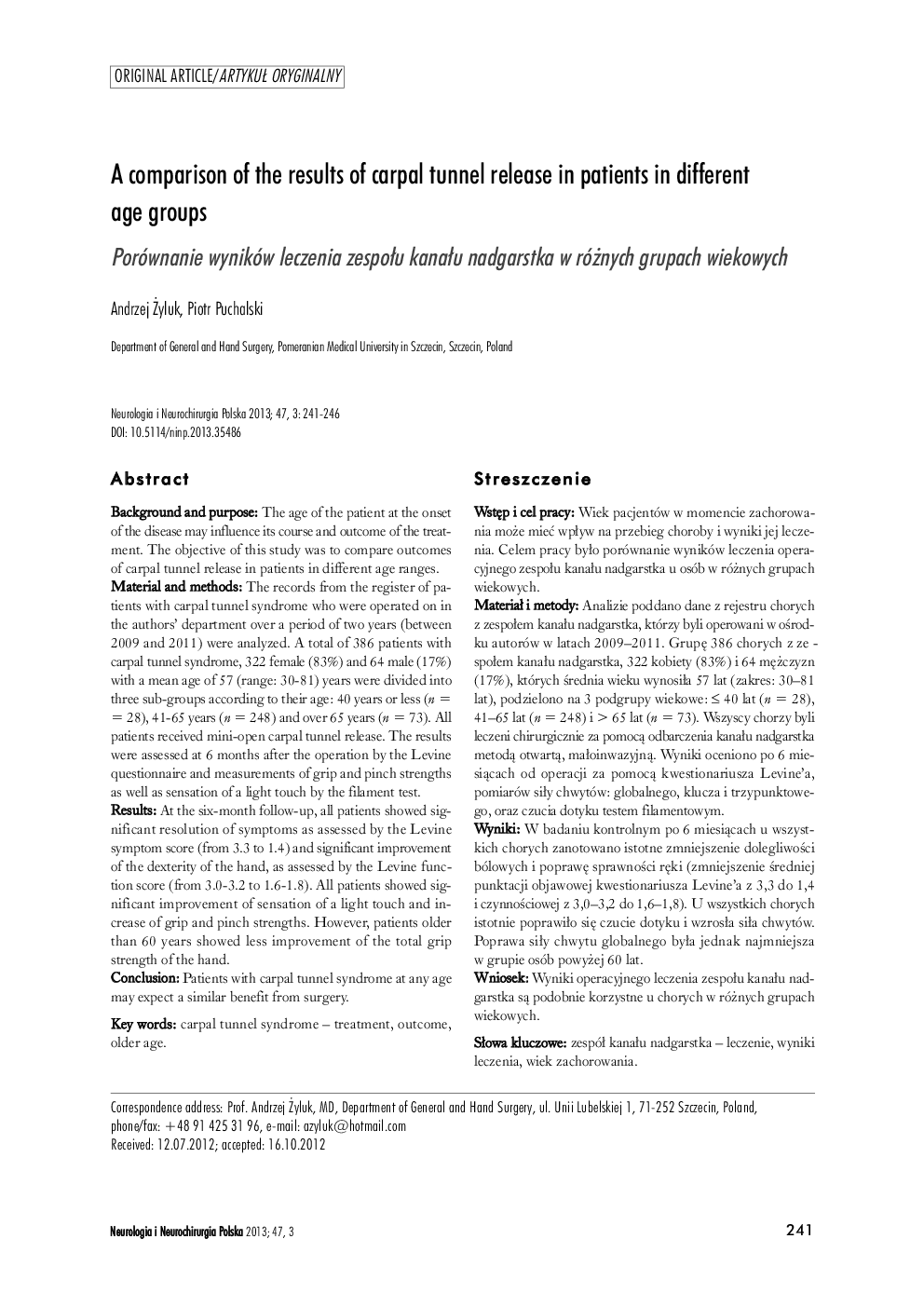| کد مقاله | کد نشریه | سال انتشار | مقاله انگلیسی | نسخه تمام متن |
|---|---|---|---|---|
| 2153005 | 1090150 | 2013 | 6 صفحه PDF | دانلود رایگان |

Background and purposeThe age of the patient at the onset of the disease may influence its course and outcome of the treatment. The objective of this study was to compare outcomes of carpal tunnel release in patients in different age ranges.Material and methodsThe records from the register of patients with carpal tunnel syndrome who were operated on in the authors’ department over a period of two years (between 2009 and 2011) were analyzed. A total of 386 patients with carpal tunnel syndrome, 322 female (83%) and 64 male (17%) with a mean age of 57 (range: 30–81) years were divided into three sub-groups according to their age: 40 years or less (n = = 28), 41–65 years (n = 248) and over 65 years (n = 73). All patients received mini-open carpal tunnel release. The results were assessed at 6 months after the operation by the Levine questionnaire and measurements of grip and pinch strengths as well as sensation of a light touch by the filament test.ResultsAt the six-month follow-up, all patients showed significant resolution of symptoms as assessed by the Levine symptom score (from 3.3 to 1.4) and significant improvement of the dexterity of the hand, as assessed by the Levine function score (from 3.0–3.2 to 1.6–1.8). All patients showed significant improvement of sensation of a light touch and increase of grip and pinch strengths. However, patients older than 60 years showed less improvement of the total grip strength of the hand.ConclusionPatients with carpal tunnel syndrome at any age may expect a similar benefit from surgery.
StreszczenieWstęp i cel pracyWiek pacjentów w momencie zachorowania może mieć wpływ na przebieg choroby i wyniki jej leczenia. Celem pracy było porównanie wyników leczenia operacyjnego zespołu kanału nadgarstka u osób w różnych grupach wiekowych.Materiał i metodyAnalizie poddano dane z rejestru chorych z zespołem kanału nadgarstka, którzy byli operowani w ośrodku autorów w latach 2009–2011. Grupę 386 chorych z zespołem kanału nadgarstka, 322 kobiety (83%) i 64 mężczyzn (17%), których średnia wieku wynosiła 57 lat (zakres: 30–81 lat), podzielono na 3 podgrupy wiekowe: ≥ 40 lat (n = 28), 41–65 lat (n = 248) i > 65 lat (n = 73). Wszyscy chorzy byli leczeni chirurgicznie za pomocą odbarczenia kanału nadgarstka metodą otwartą, małoinwazyjną. Wyniki oceniono po 6 miesiącach od operacji za pomocą kwestionariusza Levine'a, pomiarów siły chwytów: globalnego, klucza i trzypunktowego, oraz czucia dotyku testem filamentowym.WynikiW badaniu kontrolnym po 6 miesiącach u wszystkich chorych zanotowano istotne zmniejszenie dolegliwości bólowych i poprawę sprawności ręki (zmniejszenie średniej punktacji objawowej kwestionariusza Levine'a z 3,3 do 1,4 i czynnościowej z 3,0–3,2 do 1,6–1,8). U wszystkich chorych istotnie poprawiło się czucie dotyku i wzrosła siła chwytów. Poprawa siły chwytu globalnego była jednak najmniejsza w grupie osób powyżej 60 lat.WniosekWyniki operacyjnego leczenia zespołu kanału nadgarstka są podobnie korzystne u chorych w różnych grupach wiekowych.
Journal: Neurologia i Neurochirurgia Polska - Volume 47, Issue 3, 2013, Pages 241–246